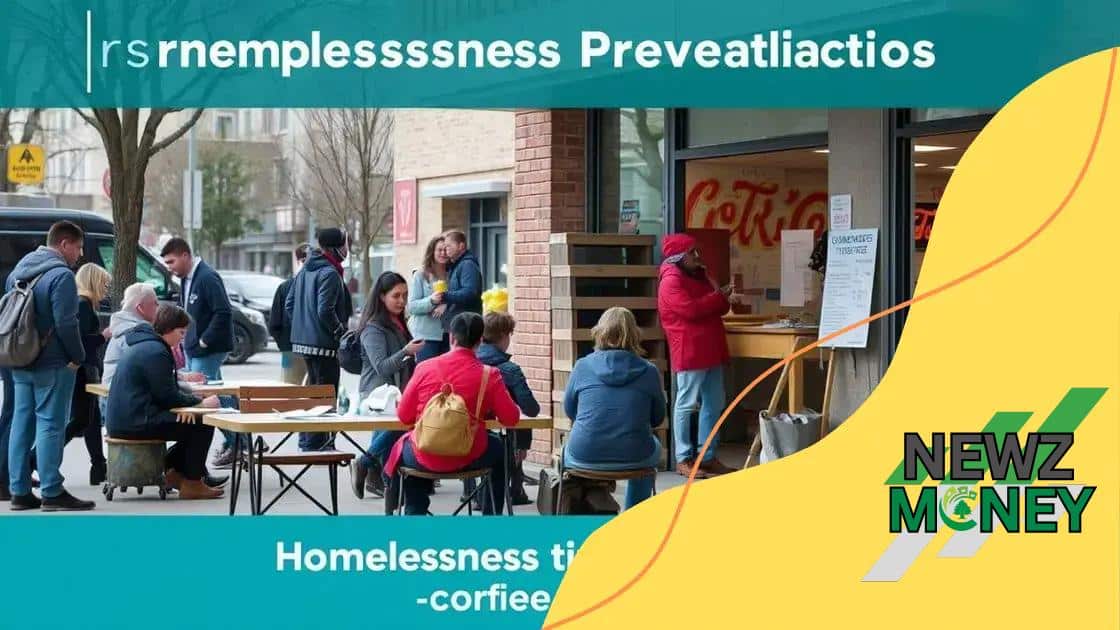Homelessness prevention programs in urban centers

Homelessness prevention programs in urban centers focus on providing essential support services, financial aid, and community engagement to help individuals maintain stable housing and avoid the risks of homelessness.
Homelessness prevention programs in urban centers play a crucial role in supporting vulnerable populations. By addressing underlying issues and providing resources, these initiatives can help individuals and families avoid falling into homelessness. Curious about how these programs work and the impact they have? Let’s dive into the details.
Understanding homelessness in urban centers
Understanding the issue of homelessness in urban centers is crucial for developing effective prevention strategies. In cities all over the world, numerous factors contribute to the rising rates of homelessness. These include economic downturns, a lack of affordable housing, and systemic issues like mental health and addiction.
To truly grasp the complexity of homelessness, we must delve into the various elements that shape this crisis.
Key Factors Affecting Homelessness
There are several interrelated factors that contribute to homelessness:
- Economic Challenges: Job loss or low wages can drive individuals and families to the streets.
- Housing Availability: The lack of affordable housing options makes it difficult for low-income individuals to find stable shelter.
- Healthcare Access: Many homeless individuals suffer from untreated medical conditions, which can further complicate their situations.
- Social Support Systems: Without a support network, individuals may struggle to escape the cycle of homelessness.
In urban environments, the visibility of homelessness is often striking. Many people assume that homelessness is only a street-related issue, but it also affects families and individuals in shelters or temporary housing. A better understanding can foster empathy and inspire communities to take action.
Impact of Homelessness on Communities
The presence of homelessness in urban settings affects everyone, not just those directly impacted. It can lead to:
- Increased Health Risks: When people lack stable housing, they face greater health risks, which can affect public health.
- Economic Strain: Communities face high costs related to emergency services, healthcare, and law enforcement.
- Social Acceptance: Stigmatization of homeless individuals can hinder their rehabilitation and support.
Understanding these factors helps emphasize the need for comprehensive solutions. By tackling the root causes, urban centers can create a robust network of support that not only prevents homelessness but also promotes a healthy community.
Key components of effective prevention programs
The key components of effective homelessness prevention programs are vital for ensuring that individuals and families receive the support they need. These programs often combine multiple strategies to address the complex nature of homelessness.
By focusing on prevention, these initiatives can help people maintain their housing and avoid the risks associated with being without shelter.
Critical Elements of Successful Programs
Successful programs tend to share several essential features:
- Housing Stability: Providing resources that help individuals secure and maintain stable housing is crucial.
- Financial Assistance: Programs that offer short-term financial aid for rent or utility payments can prevent eviction.
- Comprehensive Support Services: Access to counseling, health services, and job training helps ensure holistic support for those at risk.
- Community Partnerships: Collaborating with local organizations enhances program effectiveness by pooling resources and expertise.
When these components work together, they create a robust framework that addresses both immediate needs and long-term solutions. By increasing access to resources, individuals can find sustainable paths out of poverty.
Moreover, ongoing outreach is also essential. Programs that actively engage with the community are better equipped to identify at-risk populations. This proactive approach ensures that potential issues are addressed before they escalate into crises.
Outcome Tracking and Adjustment
Monitoring and evaluating program outcomes is crucial for continuous improvement. Effective homelessness prevention programs track metrics such as:
- Success Rate: How many participants maintain stable housing after receiving assistance?
- Community Impact: What are the broader effects on local homelessness rates?
- Participant Feedback: Gathering insights from those served helps to refine the program’s approaches.
Through careful tracking and adjustment, these programs can adapt to meet the evolving needs of the community and enhance their effectiveness over time.
Success stories from urban areas

Success stories from urban areas can truly inspire hope and highlight effective approaches to homelessness prevention programs. These narratives are vital in showing how targeted efforts can lead to positive outcomes for individuals and communities alike.
By sharing these stories, cities can learn from each other and adopt practices that have made a difference.
Real-Life Examples
Several urban centers have implemented successful programs that made significant impacts:
- New York City: A program focused on rapid rehousing has successfully reduced chronic homelessness by providing families with immediate housing solutions and support services.
- Los Angeles: Through coordinated outreach efforts, the city has seen a decrease in homelessness among veterans by connecting them to housing and healthcare services.
- Seattle: The low-barrier shelters created in Seattle offer accessible options for those in need, leading to a noticeable drop in street homelessness.
These examples demonstrate that with the right strategies, urban areas can significantly reduce homelessness rates while improving overall community health.
Moreover, personal stories from individuals who have benefited from these programs often reflect profound transformations. For instance, many individuals who once faced uncertainty now have stable housing and jobs. Success stories frequently include themes of resilience and empowerment, emphasizing the importance of personalized support.
Community Involvement
The role of community involvement in these success stories cannot be overlooked. Local organizations and volunteers often contribute valuable resources, helping to create a safety net for those at risk of homelessness.
Additionally, events that raise awareness about homelessness educate the public and encourage further support for prevention programs. Communities that unite to fight homelessness can foster an environment where individuals feel valued and supported.
As these stories spread, they serve to motivate others, proving that progress is possible when compassion and action come together in urban settings.
Challenges faced by prevention programs
Challenges faced by homelessness prevention programs are significant and can impact their effectiveness. Understanding these hurdles is vital for developing solutions that enhance program outcomes.
Despite the best intentions, many programs encounter barriers that hinder their ability to assist vulnerable populations.
Funding Limitations
One of the most persistent challenges is securing adequate funding. Many prevention programs rely on government grants, which can fluctuate based on political priorities and budget constraints. Additionally, private donations may not always be reliable, leading to inconsistent resources.
- Inconsistent funding: Programs often face periods of uncertainty, making it hard to plan long-term assistance.
- High operational costs: Running effective services can be expensive, from staffing to facility maintenance.
- Competition for funds: Numerous organizations vie for limited resources, complicating efforts to secure necessary financial support.
When funding is limited, the range of services that programs can offer may diminish, impacting their overall effectiveness.
Community Engagement
Engaging the community is essential, yet it is a significant challenge for many prevention programs. Some communities may lack awareness of available services or the urgency of the homelessness crisis.
Building trust with the individuals needing support can also be difficult, as many may have experienced stigma or negative interactions with social services in the past. This lack of trust can lead to:
- Low participation rates: Individuals may not seek help if they don’t believe services will meet their needs.
- Stigmatization: The negative perception of homelessness can hinder public support for prevention initiatives.
- Barriers to information access: Some populations may not have easy access to information about available resources.
These challenges highlight the importance of community outreach and education, ensuring that people know where to turn for help.
Systemic Issues
Another layer of complexity is the systemic issues that contribute to homelessness. Factors such as mental health, addiction, and poverty require comprehensive solutions, which prevention programs may not fully address.
Without collaborating across sectors, such as healthcare and employment, programs may struggle to provide holistic support. Integrating services is essential yet often challenging due to:
- Lack of coordination: Different service providers may not communicate effectively, leading to gaps in support.
- Complex eligibility requirements: Individuals may find it difficult to navigate through multiple systems to obtain needed services.
- Limited knowledge of available resources: Some clients may not be aware of what services exist or how to access them.
Addressing these systemic issues requires a concerted effort from all levels of government and community organizations.
How to get involved with local initiatives
Getting involved with local initiatives related to homelessness prevention programs is a rewarding way to make a difference in your community. Many people want to help but might not know where to start. There are various avenues to contribute, and every effort counts.
Engaging with local programs can enhance awareness of the issue and provide support to those in need.
Volunteer Opportunities
One of the easiest ways to get involved is by volunteering your time. Local organizations often look for volunteers to help with various tasks, including:
- Direct outreach: Distributing food, clothing, and hygiene products to individuals experiencing homelessness.
- Event organization: Helping plan and manage events that raise awareness and funds for prevention programs.
- Administrative support: Assisting with office work like data entry, answering phones, or organizing files.
- Tutoring or mentoring: Offering skills training or mentoring to help those affected rebuild their lives.
By committing a few hours each week or month, you can have a meaningful impact on individuals in your area.
Support Local Fundraising Efforts
Another way to contribute is by supporting fundraising initiatives. Many programs rely on financial donations to continue their vital work. You can help by:
- Participating in local fundraisers: Attend events like charity runs, dinners, or auctions to raise money for prevention programs.
- Donating items: Contributing clothes, food, or household goods can directly benefit those in need.
- Creating a crowdfunding campaign: Start your own campaign to raise awareness and funds for a local initiative.
Supporting fundraising initiatives not only provides financial support but also helps to raise awareness about homelessness in your community.
Advocacy and Education
Being an advocate for homelessness prevention is also essential. You can educate yourself and others, helping to break down stigma and mobilize action within your community. Some ways to advocate include:
- Sharing information: Use social media to share articles and information about homelessness and local programs.
- Engaging in local government meetings: Attend city council meetings to voice support for policies that benefit homeless prevention initiatives.
- Joining advocacy groups: Collaborate with local organizations working on systemic changes related to homelessness.
Staying informed and vocal can help mobilize community resources to tackle homelessness effectively.
Each of these steps can foster change in your area. Whether through volunteering, fundraising, or advocacy, every effort contributes to creating a more supportive community for individuals facing homelessness.
In conclusion, engaging with local homelessness prevention programs offers everyone an opportunity to make a meaningful difference. Whether you choose to volunteer, support fundraising initiatives, or advocate for systemic change, your actions can contribute to improving lives in your community. Every small effort helps build a stronger support network for those in need. By working together, communities can create solutions that not only address homelessness but also promote compassion and understanding.
FAQ – Questions about homelessness prevention programs
What can I do to help prevent homelessness in my community?
You can volunteer your time, support local fundraising efforts, or advocate for systemic changes that benefit prevention programs.
How can I find local homelessness prevention programs?
You can search online for community organizations, contact local government offices, or check social media for initiatives in your area.
Are donations to homelessness prevention programs tax-deductible?
Yes, most donations to registered nonprofit organizations are tax-deductible. Be sure to keep your receipt for tax purposes.
What types of items can I donate to support those at risk of homelessness?
You can donate clothing, non-perishable food items, hygiene products, and household goods to local shelters and outreach programs.





